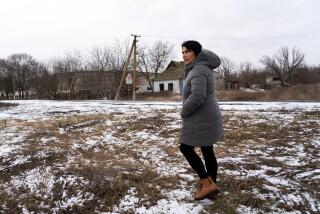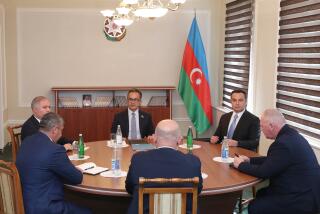In Uzbekistan, Troops Close Center of Volatile Eastern City
- Share via
MOSCOW — Uzbek troops sealed off the center of the eastern city of Andijon on Sunday as President Islam Karimov’s government sought to suppress information about a bloody crackdown there last week on thousands of protesters and militants.
More detailed reports of Friday’s carnage continued to emerge as relatives buried the dead, even though authorities were trying to keep journalists away from Andijon. Human rights activists, a doctor and others in the city have placed the death toll at 300 to 500.
Andrei Babitsky, a Russian reporter for U.S.-funded Radio Free Europe/Radio Liberty, said in a telephone interview from Andijon on Sunday that the city center was blocked off by police and soldiers.
“The town itself is locked up, approach roads are closed, and there are checkpoints at the town’s entrances,” Babitsky said. “We had to use a bypass road. The downtown is completely blocked.”
A colleague of Babitsky’s, Sadriddin Ashurov, a reporter for the station’s Uzbek Service, said he had left Andijon on Saturday night because of a death threat.
Meanwhile, a crossing into Kyrgyzstan from the Uzbek town of Korasuv was reopened Sunday, but elsewhere along the border there were reports of clashes as people fled Andijon. The Russian news agency Interfax quoted one refugee who described the scene at the border.
“There were about 1,000 people in our group,” said the man, who was not identified by name. “We came under fire several times from Uzbek military ... although we told them we were civilians from Andijon. We last came under fire from Uzbek border guards when we were trying to cross into Kyrgyzstan.” The man said four people in his group were killed and others were wounded.
In what seemed to be a separate incident, residents of the Uzbek border village of Tefektosh said that several people died in a predawn skirmish Sunday between armed men and government forces, Associated Press reported. About 500 people, including militants, crossed into Krygyzstan after the clash, villagers said. One villager said that eight government troops were killed.
Friday’s clashes in Andijon began shortly after midnight when a group of armed men stormed a prison and released hundreds of inmates; various sources said that 600 to more than 2,000 prisoners were freed. Those released included 23 prominent businessmen who are alleged adherents of an Islamic group called Akramia. They were on trial, charged with religious extremism.
Other freed inmates included ordinary criminals as well as political prisoners.
Human rights groups have estimated that Uzbekistan, a U.S. ally in Central Asia, holds about 6,000 people on political or religious charges.
Uzbek officials said that nine people were killed in the predawn clashes in Andijon, apparently including some bystanders.
Some of the freed prisoners immediately joined a large protest that developed in the city center. Most of the deaths occurred late Friday afternoon, when troops fired on demonstrators in a central square, stormed a government building held by armed militants and shot at a group of about 2,000 protesters who had broken off from the main rally, some of them carrying weapons.
Despite numerous witness reports that many unarmed civilians were slain, the Uzbek government said that only criminals and Islamic militants were killed when troops opened fire Friday.
Speaking at a Saturday news conference in Tashkent, the capital, the president offered only sketchy information on the crackdown and denied that troops shot innocent civilians. Karimov said 10 soldiers and “many more” militants died in the fighting.
But in Britain, Foreign Secretary Jack Straw denounced “a clear abuse of human rights, a lack of democracy and a lack of openness” and called on Uzbekistan to allow the Red Cross and foreign observers to establish what had happened.
In Andijon, Kodyrzhon Ergashev, chairman of the local chapter of the International Committee for Human Rights, described in a phone interview Sunday how he and his deputy had been held hostage in the government building for hours and then used as human shields when troops approached.
Ergashev said he had spoken out in support of the 23 businessmen during their trial, but went to the government building to criticize Akramia members for resorting to violence and taking over the complex.
“We told them that they were setting the opinion of the international community against themselves,” he said. “I told them that there was a positive opinion toward them before, but now when a number of innocent people have already died in town it could change. After that they forced us to our knees and tied our hands.”
Ergashev said he was beaten, and then his possessions were taken. “One of the militants told me that I will die soon anyhow. And because of that, he took off the wedding ring from my hand and took all the money from my pockets.”
Police officers, firefighters and emergency service workers were among about 25 hostages held by the militants, he said.
In the early evening, as troops closed in on the building, the hostages were tied neck-to-neck and forced to walk with the militants toward the edge of town, where they encountered soldiers in armored vehicles, he said.
“A cross-fire started. It was a miracle that I fell down first,” he said. “Some other people fell on me later. I was lightly injured in my back, and those who fell on me were all killed. There were only four [hostages] who survived.... We lay under dead bodies all night. And on Saturday morning, when police and government troops arrived, we were delivered to the regional hospital.”
Ergashev said he was amazed at how the militants had behaved.
*
Yakov Ryzhak in The Times’ Moscow Bureau contributed to this report.
More to Read
Sign up for Essential California
The most important California stories and recommendations in your inbox every morning.
You may occasionally receive promotional content from the Los Angeles Times.










